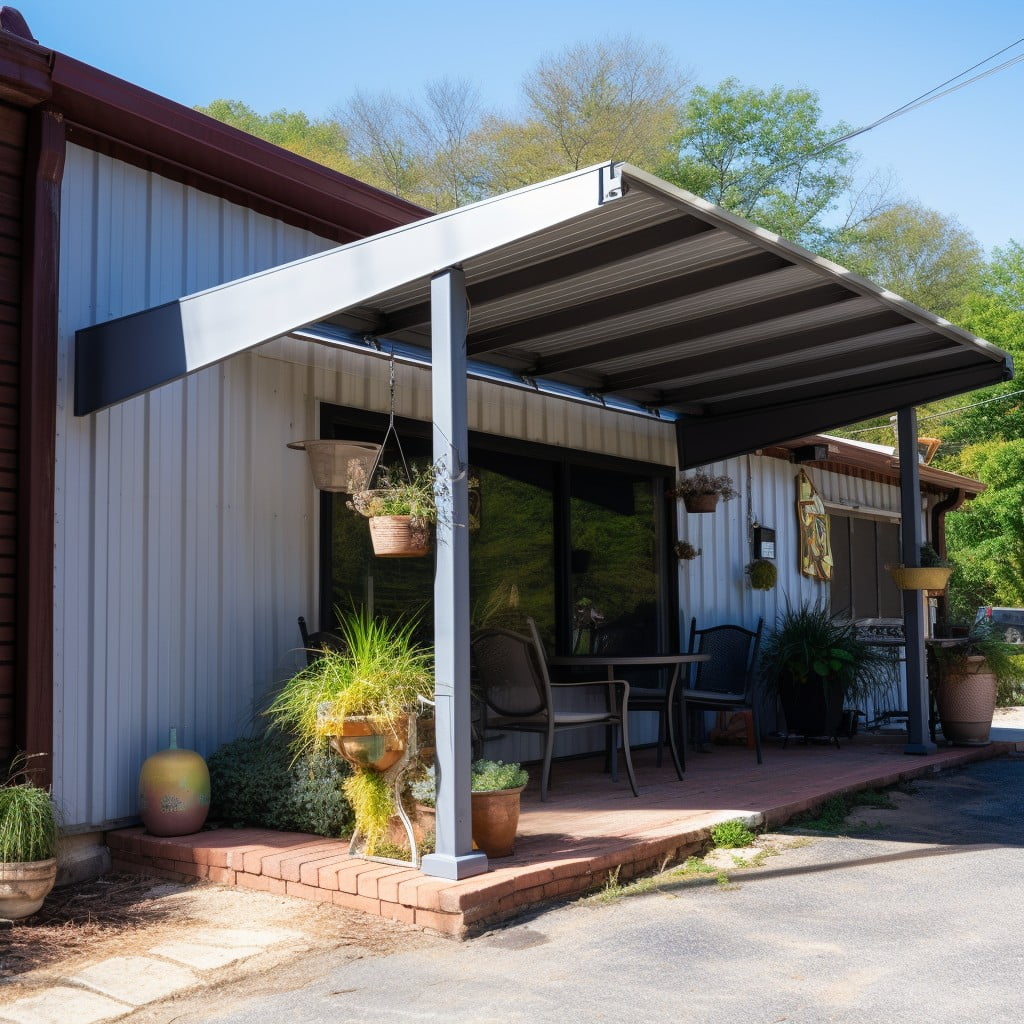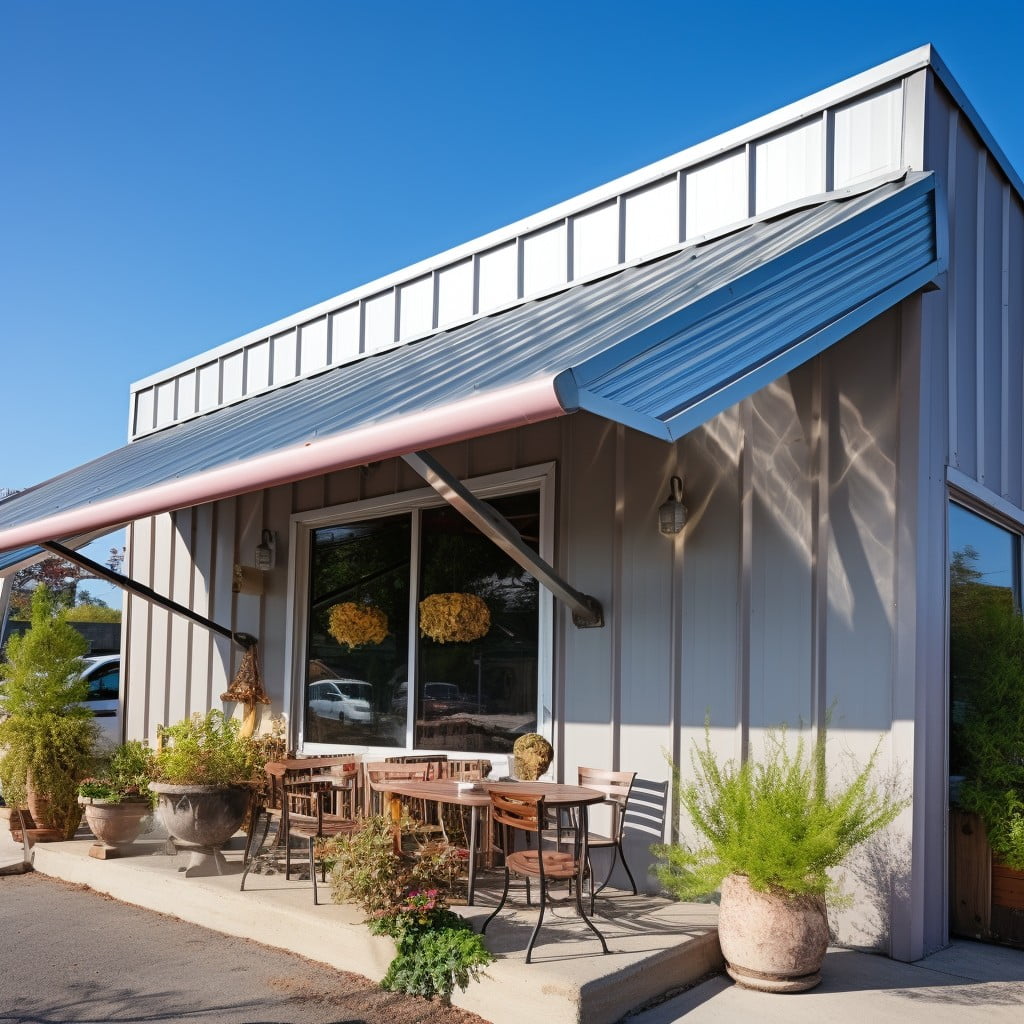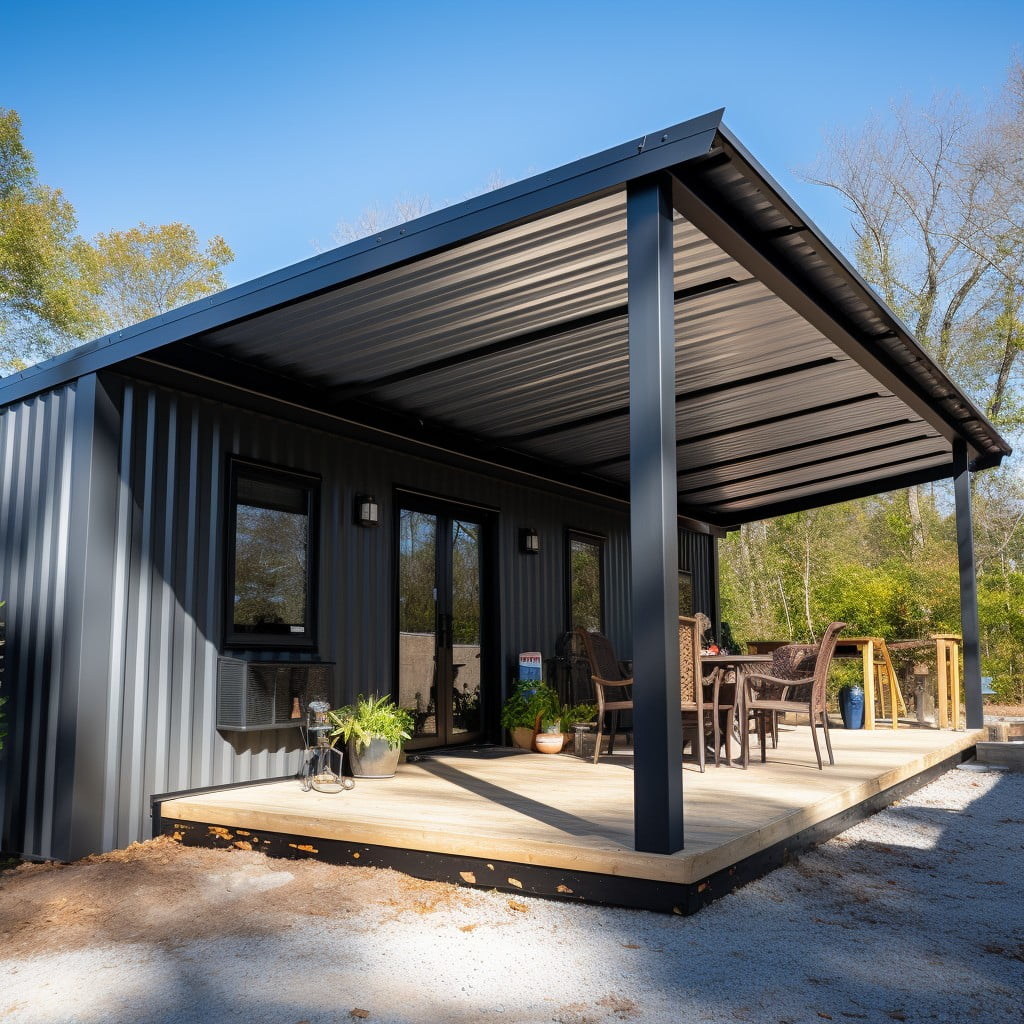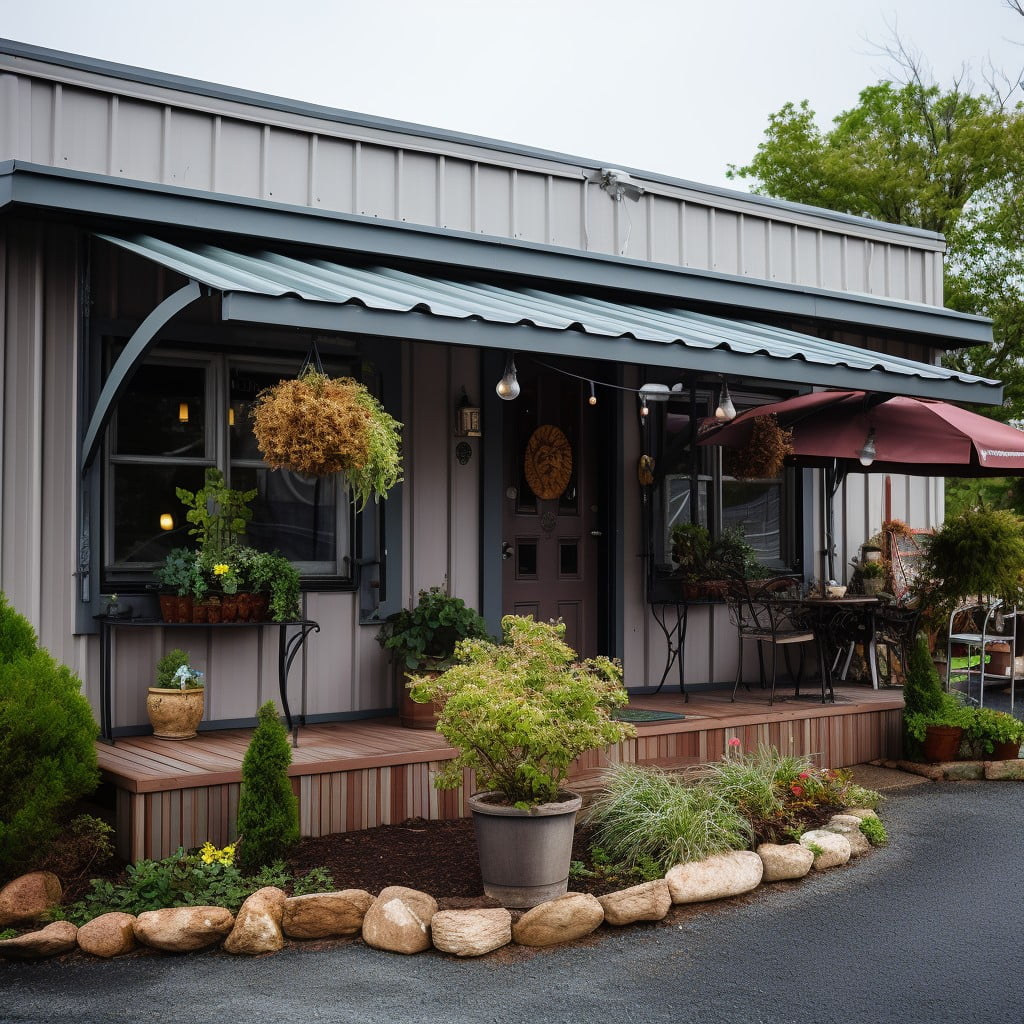Explore the simple process of adding an awning to a metal building, enhancing its functionality and aesthetic appeal.
Adding an awning to a metal building can enhance its functionality and aesthetic appeal. This process requires careful planning, the right materials, and a basic understanding of construction principles.
In this article, we’ll delve into a step-by-step guide on how to attach an awning to a metal building, discussing everything from choosing the right awning and tools, to the actual installation process.
Whether you’re looking to provide shade, protection from the elements, or simply add a decorative touch to your metal building, this comprehensive guide has got you covered.
Stay tuned for all the details you need to successfully complete this project.
Key takeaways:
- Consider aluminum or tin for your awning roof material.
- Aluminum and tin have different advantages and trade-offs.
- Metal awnings can last 30-40 years with proper maintenance.
- Choose aluminum or steel for a durable frame.
- Regular maintenance is key to extending the life of your awning.
Selecting the Right Metal for Your Awning Roof

Consideration of material properties is essential for enhanced performance and durability. Typically, the most favored choices are aluminum and tin, though each comes with unique advantages and trade-offs.
Aluminum is lightweight and resistant to rust, ensuring a longer life span. Its low weight makes it easy to install and reduces the load on the building structure. Conversely, aluminum can be susceptible to denting due to heavy impacts, such as hail or debris in strong winds.
On the other hand, tin is a more cost-effective option. It is heavier than aluminum and can withstand harsher impacts without denting. However, it requires regular maintenance to prevent rusting.
Understanding the pros and cons of each metal helps in making an informed decision that suits your locale and climate, ensuring your chosen awning delivers optimal performance throughout its lifespan.
Comparison Between Aluminum and Tin for Awning Roofs

When it comes to awning roofs, aluminum and tin are two popular choices. Aluminum is notably lightweight and resistant to rust, making it a low-maintenance option. It’s capable of withstanding harsh weather conditions and can last over 60 years. Aluminum awnings come in a variety of colors and designs, adding a stylish touch to your building.
Tin, on the other hand, exhibits supreme durability. Although heavier than aluminum, tin awnings can last up to 40 years when correctly maintained. Tin is a much stronger material, which better withstands physical impacts.
But it’s essential to consider that tin requires a protective coating to prevent rusting. While they generally cost less than aluminum, the additional expenses for coating and the potential need for more frequent replacements should be factored into your decision. Both alternatives have their pros and cons, and your choice should align with your specific requirements and preferences.
Understanding the Longevity of Metal Roof Awnings

When it comes to the lifespan of metal awnings, it’s important to note that they are a long-term investment, boasting endurance that exceeds many other types. Given proper maintenance, you can expect about 30 to 40 years of use from a steel awning, and about 12 to 20 years from a metal fabric one.
Aluminum, a commonly used material, also promises longevity. If maintained well, such awnings can last up to 40 years. Nevertheless, the lifespan will significantly rely on factors like the climate and weather conditions in your area, as harsh conditions may contribute to faster deterioration.
Tin, on the other hand, may not match the durability of steel or aluminum, but still offers a decent lifespan of around 30 years with appropriate upkeep. In general, investing in a more robust metal may be more cost-effective in the long run, considering the reduced frequency of replacements.
Bear in mind that while these materials are known for their endurance, routine care and inspection can significantly extend the life of your awning. Therefore, regardless of which metal you opt for, regular maintenance is paramount.
Choosing the Best Frame for a Metal Awning

Aluminum and steel stand as the most recommended materials due to their robust and reliable nature. Aluminum, lighter and more flexible, lends itself well to complex shapes and designs, although it may require reinforcement in areas prone to high winds. Steel, heavier and sturdier, withstands harsh weather conditions effectively but might be overkill for milder climates.
Choosing between powder-coated and galvanized frames is also crucial. While both add a protective layer to prevent rust, powder coating brings more color options to the table, matching your building aesthetics better. Galvanization, on the other hand, provides superior resistance against corrosion, best for buildings situated in high-humidity or coastal areas.
Remember, the frame selection should balance functionality and aesthetics. The frame must stand strong against local climate conditions while subtly complementing your building design. In the end, a durable, weatherproof, and visually appealing awning hinges on your chosen frame’s quality.
A Step-by-step Guide On Metal Awning Installation
To embark on the installation process, acquire all necessary materials upfront. This includes your selected metal for the awning, a suitable frame, and appropriate fasteners. The tools you’ll require could range from a measuring tape, level, and marking pen, to a drill, metal cutter, and ladder.
Start by establishing accurate measurements. Determine the length, width, and slope of your awning and mark these dimensions on your building. This serves as a blueprint for your installation and ensures precision throughout the process.
Next, assemble the metal awning frame based on the manufacturer’s instructions. It’s here you affix the awning mounts to your building, using the drill for secure installation. The positioning of these mounts should align with the previous markings for optimal fit and aesthetic consistency.
With your frame firmly attached, it’s time to cut your metal awning material. Match the measurements obtained earlier to ensure the awning fits flawlessly onto the frame. Always prioritize personal safety when using metal cutting tools.
Lastly, secure the cut metal pieces onto the frame. Fasteners come into play here – screws or bolts, adhering to the manufacturer’s recommendation. Inspect the installation for any loose elements and adjust accordingly. Be careful to maintain the integrity of your metal building during these steps.
Maintenance Practices for Metal Awnings
Proper care ensures longevity of your metal awning. Routine checks should be performed, specifically looking out for rust or damage, particularly after severe weather conditions. Clearing debris, like leaves or branches, prevents water from pooling and causing rust or corrosion over time.
Cleaning your awning should be done at least twice a year. A soft brush and a solution of water and mild detergent are usually sufficient. Be sure to rinse thoroughly to avoid cleaning solution residues, which could harm the metal.
Inspect the fasteners, screws, and bolts regularly. Loose or missing parts should be tightened or replaced to maintain the structural integrity of your awning.
Coating maintenance is also crucial. Awnings with a natural finish should have a clear protective coating reapplied once the original has eroded. If your awning is painted, check periodically for chipping or peeling and repaint as needed.
Lastly, consider professional maintenance services, especially if your awning is large or hard to access. They’ll have the proper tools and experience to spot potential problems and deal with them effectively.
By implementing these steps, you’ll ensure optimal performance and increase the lifespan of your metal awning.
Considerations When Adding an Awning to a Metal Building
To embark on this project, take into account the building’s architectural style and the specific requirements. The awning should complement the existing design, not clash or detract from it.
Consider the size of the awning. This largely depends on the purpose it serves: whether it’s for sun protection, rain shield, or aesthetic enhancement. Run thorough measurements to ensure proper coverage and balance.
The positioning of the awning plays a crucial role. Aim for optimum functionality without sacrificing visibility or access. For instance, place it high enough to avoid obstructing doors or windows.
Material selection is key. Pick a metal that can withstand environmental conditions typical for your area. For instance, corrosion-resistant metals are important in regions with extensive rainfall or humidity.
Regulations and permit requirements may apply in your locality. Some regions require permits to install awnings, especially for commercial buildings. It’s best to check and comply to avoid legal inconveniences.
Budget constraints? They can influence the quality, size, and type of awning. While higher-priced options often provide durability and less maintenance, there are affordable alternatives that still offer reasonable quality.
Remember, adding an awning should enhance the building’s utility and appearance, so thoughtful consideration is paramount.
FAQ
How much does it cost to build a metal awning?
The average cost for a metal awning installation fluctuates between $350 and $1,150, translating to an estimated cost of $10 to $90 per square foot, inclusive of installation.
What materials are most reliable for constructing a metal awning?
Aluminum and steel are the most reliable materials for constructing a metal awning due to their durability, corrosion resistance, and low maintenance requirements.
What are the key steps involved in the installation of a metal awning to an existing building?
The key steps involved in the installation of a metal awning to an existing building include planning and designing the awning, preparing the installation area, attaching the mounting brackets, assembling the awning, and securing it to the brackets.
What are the maintenance considerations for metal awnings?
Maintenance considerations for metal awnings include regular cleaning to prevent rust, checking for loose fittings, and promptly treating any visible damage to ensure longevity and performance.
Recap




